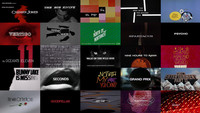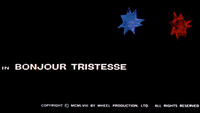Author Pat Kirkham discusses the opening titles for Walk on the Wild Side, designed by Saul and Elaine Bass, from her authoritative book Saul Bass: A Life in Film and Design.
For this film, now regarded as one of the all-time Bass classics, Saul and Elaine decided upon a live-action title sequence starring a black tomcat on the prowl, as a metaphor for the "back-alley conflicts" within a film set in the red-light district of New Orleans during the Depression.
Saul described the title sequence thus:
"The film's setting is New Orleans in the early thirties, and deals with the disenfranchised, tough, seamy characters of a despairing time. Symbolic of this is the black cat and its movement through this environment. The title opens with him emerging from a culvert and looking around. We watch him prowl through the back alleys, roam through his territory, meet another cat, an outsider, a quick fight, the intruder scuttles off. The cat resumes his stealthy 'Walk on the Wild Side.'"
The feline eyes and paws keep moving to the bold, sexy rhythm of Elmer Bernstein's jazz-like score while the credits come and go. When the miniature drama shifts to a staccato-like fight, horns blare out as the cuts occur, in one of the best Bass/Bernstein collaborations.
Saul recalled:
“Walk on the Wild Side was one of my very early live-action titles. I decided I would, in this title, try to come to grips with what seemed a challenging aspect of creative endeavor. And that is, to deal with ordinary things, things we know so well that we've ceased to see them. And deal with them in a way that allows us to understand them anew. The challenge was how to restore our original view of a cat, when it was new, strange, exotic (perhaps even before our point of memory), and transform it into a pervasive presence.
We used various devices. We overcranked. That dramatically increased the size of the cat. The slower the motion, the greater the apparent body and weight, because big cats, leopards, move more ponderously than small domestic cats.
Then we closed in on the cat's paw. Something one never sees ordinarily. Overcranked and close up, the way that paw meets the ground forces you to reexamine the whole notion of what this animal is.”
Pat Kirkham is Professor in the History of Design, Decorative Arts and Culture at the Bard Graduate Center for Studies in the Decorative Arts, Design & Culture, New York. She has written and edited a number of books, including Charles and Ray Eames (1998) and Women Designers in the USA 1900–2000 (2001).
©2011 Laurence King Publishing Ltd. Used with permission.
Titles Designed by: Saul Bass, Elaine Bass
Music by: Elmer Bernstein
Discover more Saul Bass

SAUL BASS: A LIFE IN FILM AND DESIGN
By Jennifer Bass and Pat Kirkham










